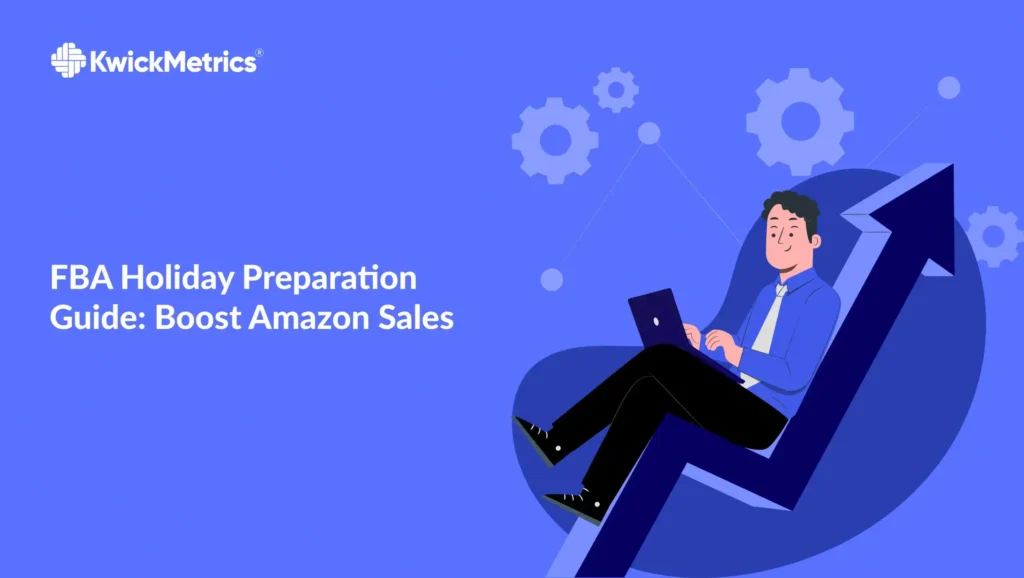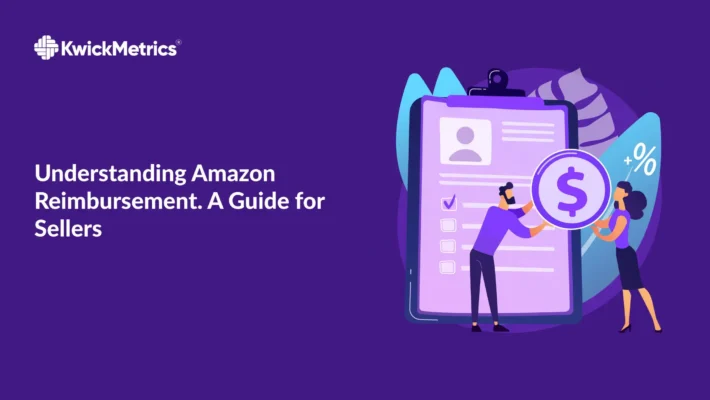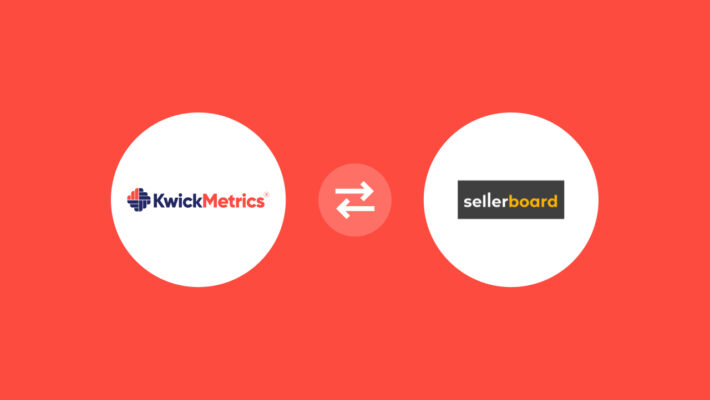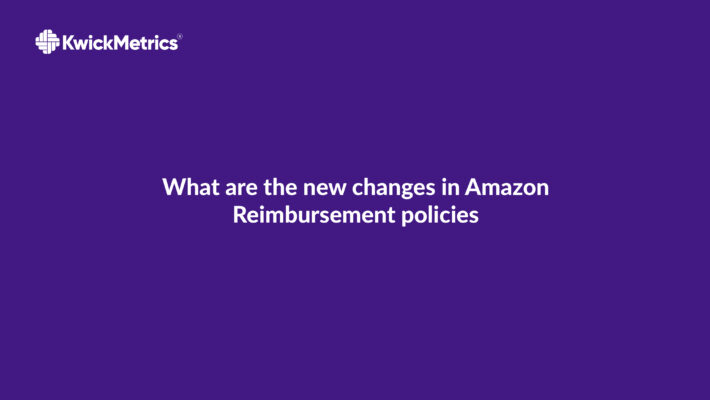FBA Holiday Preparation Guide: Boost Amazon Sales

Table of Contents
- Understanding FBA Holiday Preparation Guide
- Boost Your Sales With KwickMetrics
- Starting Early for Holiday Season Sale
- Optimizing Pricing Strategy for Holiday Season
- Minimizing Returns during Holiday Season
- Try Our KwickMetrics - One Tool with Multiple Solutions!
- Planning Offers, Discounts and Promotions
- Effective Use of PPC Campaigns
- Managing Inventory for Holiday Sale
- Business Optimization for Increased Profit
- FAQs in Relation to Fba Holiday Preparation Guide
- Conclusion
- Explore Our Features!
Ever watched a relay race and marveled at the precision, the anticipation, each runner passing on the baton smoothly to their teammate? That’s what prepping your FBA holiday preparation guide feels like. It’s about anticipating market trends, understanding customer behavior during shopping season, tweaking your product listings just right for those holiday keywords… all while keeping an eye out for that Amazon fulfillment center cut-off.
This isn’t merely a game of sales volume or search terms; it’s a marathon sprint through Prime Day, Black Friday and Cyber Monday with one aim – maximize profit.
If you’ve been an Amazon seller for any amount of time, you know this truth: running deals without a plan is like trying to win that relay race blindfolded. So how do we rip off that blindfold?
Guess what? You’re fortunate to have me here, prepared and eager to lend a hand!
Understanding FBA Holiday Preparation Guide
The festive season is a hectic time for e-commerce vendors, so Amazon sellers need to be prepared. This preparation involves understanding Amazon’s policies, updated fees, and promotional opportunities specific to the holidays.
To help you navigate this busy period, we’ve crafted an all-encompassing FBA holiday preparation guide that covers everything from pricing strategy to inventory management. The goal? To make sure your business doesn’t just survive but thrives during the upcoming shopping frenzy.
Familiarize Yourself with Amazon Policies and Fees
A key part of preparing for the holiday season is being well-versed in Amazon’s policy updates and fee changes. One such update worth noting is Amazon’s Holiday Peak Fulfillment Fee for FBA orders which kicks in during a specified period.
This knowledge will not only save you from unexpected expenses but also allow you to price your products competitively while maintaining profitability – crucial when it comes down to winning that Buy Box.
Leveraging Promotional Opportunities
Holidays are synonymous with deals. So why not use this consumer expectation as an opportunity?
Promotions like Lightning Deals or Coupons can work wonders in driving traffic towards your product listings. Not only do they increase visibility by getting featured on deal-specific pages, but they also boost sales volume thanks largely due to consumers’ fondness for bargains.
Nailing Your Pricing Strategy
An effective pricing strategy isn’t just about staying competitive—it’s about striking a balance between demand (which often skyrockets around the holidays) and profitability (keeping those special fees in mind).
Remember, it’s not just about getting the sale. It’s also about making sure that every sale contributes to your bottom line. After all, what good is increased sales volume if it doesn’t translate into healthy profits?
Wrapping Up
To sum up, successful FBA holiday preparation involves a keen understanding of Amazon’s policies and fees along with an ability to optimize promotional opportunities and pricing strategies for maximum profitability.
Boost Your Sales With KwickMetrics
Explore 14-day free trial! No credit card required, cancel at any time.
Key Takeaway:
Prepping for the holiday rush on Amazon means mastering their policies and fees, seizing promotional opportunities, and nailing your pricing strategy. The aim? To drive traffic to your product listings, boost sales volume while keeping costs in check, ensuring each sale contributes positively to your bottom line.
Starting Early for Holiday Season Sale
The holiday season is like the Super Bowl of retail, especially for Amazon sellers. And just like a football team wouldn’t wait until game day to start training, you shouldn’t hold off on your FBA holiday preparation either.
The Importance of Early Preparation
To score big during the shopping season frenzy, starting early can be your secret weapon. As per our research at KwickMetrics, there are specific tasks that need attention 10-12 weeks before peak season hits. This timeline gives you enough leeway to iron out any potential wrinkles in operations and boost sales.
This isn’t about rushing; it’s about ensuring that everything runs smoothly when those orders begin flooding in from eager customers looking for their perfect holiday deals.
In this busy period where every second counts – from managing product listings to adjusting PPC campaigns – starting ahead helps avoid last-minute hassles and ensures successful fulfillment center operation.
As we move closer towards the holidays (7-9 weeks out), focus shifts more towards optimizing pricing strategies taking into account special fees introduced by Amazon during this time. It’s also wise then to revamp your return policy if needed because let’s face it: no one wants a pile-up of unwanted gifts after Christmas.
Dialing back another couple of weeks (4-6 weeks prior), kickstart running deals using promo codes or even sponsored brands’ advertisements via Seller Central – anything that’ll make sure customers know what amazing products await them under their tree.
Bidding Strategy and Review Automation
Last but not least, three weeks out is the time to ramp up your PPC campaigns. With increased search volume and potential for higher sales data, it’s important to get aggressive with your bidding strategy.
At the same time, leveraging review automation tools can help bolster customer reviews and increase chances of conversion – because who doesn’t trust a product that has glowing reviews?
All in all, an early bird approach to FBA holiday preparation will not only give you peace of mind but also set you on track for a successful holiday shopping season.
Key Takeaway:
Remember, the early bird catches the worm. This saying holds particularly true when preparing for FBA holidays. Get a head start 10-12 weeks before peak season to iron out any operational issues and get ready for high-volume sales. As the holidays approach, turn your attention towards fine-tuning pricing strategies and updating return policies. Then, about 4-6 weeks ahead of time, spark customer interest by rolling out deals using promo codes or sponsored ads.
Optimizing Pricing Strategy for Holiday Season
When the holiday season rolls around, every Amazon seller needs to have a solid plan in place. Figuring out how to maximize your pricing approach is a crucial component of readying for the holiday season. With Amazon’s special fees introduced during peak times, getting your prices right can make or break your profits.
You might be asking yourself: How do I adjust my prices without driving away customers? The answer lies in striking a balance between competitive pricing and covering any additional costs you might incur due to increased sales volume and higher fulfillment fee. And that’s where KwickMetrics comes into play.
The Impact of Special Fees on Your Pricing Strategy
A major factor influencing your pricing strategy are Amazon’s special fees applicable during the holiday shopping period. For instance, sellers need to consider the Holiday Peak Fulfillment Fee levied on FBA orders during certain weeks leading up till Christmas.
To navigate these extra charges while still turning a profit, an effective approach could involve adjusting product prices slightly upwards while running deals or offering promo codes as part of Black Friday and Cyber Monday events; not only does this offset some cost but also increases chances for boosted sales by attracting deal-hunting shoppers.
Navigating New-to-Amazon Product Fees Waivers & Loans
Sellers should take advantage of opportunities provided by Amazon like waiving select fees on new-to-Amazon products and providing loans via their lending program specifically designed to boost businesses.
This way, if you’re launching new products over holidays (which can be risky), at least there won’t be upfront storage costs associated with them. Also using loan funds judiciously can help you effectively cover holiday-related expenses, further strengthening your pricing strategy.
So remember, successful holiday preparation is not just about stocking up on inventory and marketing; it’s also about strategic price adjustments that account for special fees while remaining appealing to customers. Use KwickMetrics’ analytics tools to keep an eye on your sales data, product performance and profit margins as you adjust prices – ensuring a profitable festive season.
Key Takeaway:
Optimizing your pricing strategy for the holiday season is key to a successful Amazon FBA business. You need to balance competitive prices with covering increased costs due to higher sales volume and special fees, such as Holiday Peak Fulfillment Fee. Use tools like KwickMetrics to track your sales data and adjust accordingly.
Minimizing Returns during Holiday Season
The festive shopping season can be a blessing and a curse for Amazon vendors. Yes, the period of time when sales soar is upon us. But with that comes an increase in returns, which can eat into your profits.
You could be wondering, “How can I reduce returns?” You’re not the only one. Let’s tackle this challenge head-on by focusing on two key areas: optimizing product descriptions and improving customer service responses.
Optimize Product Descriptions
A clear and accurate product description is one of the most effective ways to prevent unnecessary returns. Customers need to know exactly what they are buying – from dimensions to functionality – so there are no unpleasant surprises when their package arrives.
Amazon’s guidelines for creating detailed listings offer helpful tips such as using high-quality photos and including comprehensive specs about your products. Also consider updating pricing according to seasonal trends; doing so may help reduce return rates even more.
Customer Service Responses
An overlooked area where many sellers could improve is in responding effectively to customer questions or issues. Often times these queries provide valuable insights into why customers decide on returning items back.
-
- If buyers have trouble setting up or using a product after purchase, well-structured guidance from your side could save them from initiating a return request.
- In cases where customers complain about missing parts or defects upon delivery — being quick at providing replacements will show that you care about their satisfaction.
TIP: Positive reviews act as social proof of good customer service response while helping future potential buyers make informed decisions, which can eventually decrease the number of returns.
In summary, by investing some time in optimizing product descriptions and customer service responses, you’ll not only minimize returns but also increase chances for repeat business – a win-win situation during the bustling holiday season.
Try Our KwickMetrics - One Tool with Multiple Solutions!
Key Takeaway:
Maximize your holiday profits by reducing returns on Amazon. Make sure your product descriptions are clear, accurate, and detailed to prevent surprises for customers. Bolster customer service responses - a quick solution can often save a return request. By focusing on these areas, you'll not only minimize returns but also increase repeat business.
Planning Offers, Discounts and Promotions
When it comes to the holiday season sale on Amazon FBA, strategic planning of offers, discounts, and promotions is crucial. These tactics can be a powerful magnet for customers hunting for the best deals.
To start with, Prime Exclusive Discounts, available through Seller Central, are a surefire way to attract Prime members who value exclusivity. It’s not just about slashing prices; you also need to consider how these discounts will affect your profit margins.
However, there is more to it than that. Consider coupling your offers with smart PPC campaigns during this peak shopping period. Not only does this increase visibility but also optimizes conversion rates when shoppers see an attractive deal right off the bat in their search results.
A successful holiday strategy doesn’t stop at price reductions though – promo codes add another layer of attraction for bargain hunters while adding a sense of urgency as they’re usually time-bound or limited in quantity.
Crafting Your Holiday Deals Strategy
Digging into sales data from previous years can provide valuable insights into what worked well (and what didn’t). Was there a particular discount rate that drove more sales? Or perhaps certain products performed exceptionally well under specific promotional conditions?
This historical analysis combined with current market trends will help tailor your upcoming holiday deals strategy. Remember: No one-size answer is effective in this situation.
Balancing Sales Volume and Profitability
The goal isn’t just boosting sales volume; maintaining profitability is equally important too. This balance could mean running deals on higher-margin items where you have some wiggle room without impacting bottom-line profit.
Strategic discounting can not only draw in more customers but also increase chances of repeat purchases. As per the stats, creating holiday deals and coupons attracts a surge of customers leading to an uptick in sales.
Capturing Customer Attention with Creative Promotions
Alongside discounts, you can also find unique promotions. Offer incentives like ‘buy one get one free’ or ‘spend $100 and receive a 20% discount on the next purchase’, to capture customer attention. Such promotions give you an exciting chance to save more.
Key Takeaway:
Don't forget to consider your profit margins while planning these promotions. It's a fine line between attracting customers with deals and maintaining business profitability. Make sure you've struck the right balance by analyzing sales data from previous years and adjusting your strategy accordingly.
Effective Use of PPC Campaigns
The holiday season brings increased traffic and competition on Amazon. To keep up, adjusting your PPC campaigns is crucial.
Bidding Strategy Adjustments for Peak Season
During the peak shopping season, you’ll need to increase both your campaign budgets and keyword bids. This helps make sure that your products are visible in this highly competitive period.
You may be wondering if increasing costs will eat into profits? But think about it as a game of high stakes poker – sometimes you have to bet more to win big.
Tweaking Your Keyword Selection
A key aspect of running successful PPC campaigns during holidays involves careful selection and use of keywords. Add holiday-related terms like ‘Black Friday’, ‘Cyber Monday’ or ‘holiday deals’ to capture more potential buyers looking for festive purchases.
This strategy can significantly boost sales volume by capturing search queries specifically related to the holiday season.
Focusing on Product Performance
To get the most out of your ad spend, focus on promoting products with good performance history over new or low-performing ones. High-converting items usually continue their trend during the sale periods too because customers already trust them. It’s similar to backing a winning horse – why risk betting on an unproven one?
Prioritizing Sponsored Brands & Display Ads
In addition, give priority to sponsored brands and display ads since they tend attract a lot more attention from shoppers than standard product listings do during this time. Think billboards versus flyers; which grabs more eyeballs?
Remember, PPC campaigns are a dynamic process. Keep an eye on your campaign’s performance and adjust accordingly for the best results.
Managing Inventory for Holiday Sale
The holiday season is a critical time to nail down your inventory management. As an Amazon vendor, you should be prepared to meet the high demand during this holiday season without having too much or not enough stock.
Seller-Fulfilled Prime can be a great alternative if you anticipate potential delays in Amazon fulfillment centers. With this program, you retain control over your inventory and can quickly respond to changes in sales volume.
Start Early with Your Inventory Planning
To avoid last-minute panic and prevent missing peak selling opportunities like Black Friday or Cyber Monday deals, start planning your FBA inventory well ahead of the holiday shopping season. Analyze past years’ sales data along with current market trends to make informed decisions about what products will sell best.
Fulfillment Center Strategy
If using Amazon’s FBA service during this busy period, keep in mind that fulfillment centers get congested due to increased product listings from sellers all aiming for successful holidays. This congestion could lead not only to longer processing times but also higher storage fees.
Promote Fast-Moving Products
In addition to stocking up on popular items based on historical sales data and search volume trends, consider adding some exclusive holiday deals into the mix – they are proven ways boost sales. It’s always good idea however ensure there’s enough stock support such promotions so customer satisfaction remains high even during busiest periods.
Mitigating Stockout Risks
Analyze your previous year’s performance against forecasted demand while taking note of unexpected peaks driven by promo codes or special offers which may have caused any sudden surge in orders; use these insights to plan your inventory levels for the upcoming season.
Monitor Inventory Levels
Monitor your inventory levels closely to ensure optimal product performance and avoid any customer trust or loyalty issues caused by “out of stock” situations, as striking the right balance is key. This helps you maintain optimal product performance and avoid any “out of stock” situations that could damage customer trust and loyalty.
Remember, it’s all about striking the right balance. Not going overboard, but also never falling short. So gear up to impress those Amazon shoppers.
Key Takeaway:
Master your holiday inventory management by starting early, using past sales data and market trends to guide stocking decisions. Opt for Seller-Fulfilled Prime to maintain control during busy periods, consider exclusive deals to boost sales but ensure enough stock is available. Monitor levels consistently to avoid stockouts and keep customer trust high.
Business Optimization for Increased Profit
The holiday season can be a great opportunity for Amazon sellers, yet it brings with it its own unique set of challenges related to inventory and customer service. On one hand, it’s the time of year when sales volume skyrockets. But on the other hand, so do challenges related to inventory management and customer service.
The key is business optimization – making tweaks to your operations that let you rake in more profit while reducing headaches. Let’s look at some ways how.
Fulfillment Centers as Backup
Sellers should anticipate potential delays in Amazon fulfillment centers. Therefore, having alternative fulfillment options lined up isn’t just smart – it could save your holiday season sale. Don’t get stuck with FBA inventory that’s not moving because of unexpected holdups at Amazon warehouses.
Financial Health Check-up
Understanding the financial health of your business is crucial before diving into high-sales periods like Black Friday or Cyber Monday. Take stock of all expenses (including those pesky special fees introduced during peak seasons) and revenues to ensure there are no unpleasant surprises down the line.
This includes keeping an eye out for any changes in fulfillment fee or policy updates by Amazon which might affect profitability.
It sounds simple but this kind of ‘health check’ can make a huge difference between struggling through holidays and sailing smoothly.
A Solid Returns Strategy
Returns can eat into profits big time if they aren’t handled well, especially during prime shopping events such as Prime Day where return volumes increase substantially.
Preparation here means setting clear expectations via product listings and maintaining stellar customer service throughout these busy times. Remember: happy customers leave positive reviews, which in turn boosts sales even more. So yes, it’s worth the effort to minimize returns and handle them efficiently when they do happen.
Amazon sellers who optimize their business for the holiday season not only see increased profit but also enjoy a smoother operation during these peak times. Because let’s face it – nothing feels better than a successful holiday sale.
Key Takeaway:
Optimizing your Amazon business for the holiday season is a must. It's not just about boosting sales, but also reducing operational headaches. This means having backup fulfillment options to combat potential delays, doing a financial 'health check' before high-sales periods, and implementing an efficient returns strategy. These steps can turn holiday challenges into opportunities for increased profit and smoother operations.
FAQs in Relation to Fba Holiday Preparation Guide
What to sell on Amazon for the holidays?
Sell items that are in high demand during the holiday season. This includes toys, electronics, fashion accessories, home decor, and kitchen gadgets.
How many hours a week is Amazon FBA?
The time spent varies greatly based on your business size. Some sellers put in 10-20 hours per week while others may spend full-time hours.
How long before Amazon FBA is profitable?
This can range from three months to over a year depending on factors like product selection, pricing strategy, and operational efficiency.
How do I add holidays to my Amazon seller account?
You can’t directly add holidays, but you can adjust shipping settings and lead times according to public holidays or any personal time off you plan to take.
Conclusion
Preparing for the holiday season with your Amazon FBA business is a marathon, not a sprint. The key takeaway from our fba holiday preparation guide should be to start early.
Analyze trends and adjust pricing strategy in line with special fees. Minimize returns by optimizing product descriptions and customer service responses.
Don’t forget about offers, discounts, promotions! They’re great tools to attract more customers during this busy shopping season.
Amp up your PPC campaigns and manage inventory effectively. Always anticipate potential delays at fulfillment centers so you never run out of stock!
Last but not least, keep an eye on financial health and prepare for those inevitable holiday returns.


